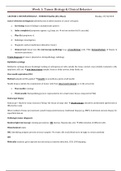College aantekeningen
Lecture Notes - TBCB - week 1
Lectures included: cancer histopathology, lab techniques in cancer research, mass spectrometry & proteomics, CRC biomarkers, cancer epidemiology, tumor profiling & biomarkers (case: hemato-oncology), NGS for personalized cancer treatment, prostate cancer profiling, microbiome & cancer
[Meer zien]




